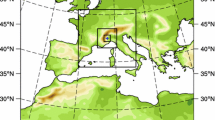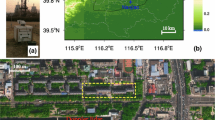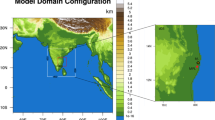Abstract
We evaluated the performance of the Weather Research and Forecasting Model in simulating the boundary-layer structure at an urban site in Seoul on two clear summer days against observations made using a ceilometer, a Doppler wind lidar, and a microwave radiometer. The planetary boundary-layer height (PBLH) was estimated from two different methods using observations: the ceilometer-based method (CBM) and bulk Richardson number method (BRM). The maximum PBLH was well captured by the model but PBLH was underestimated in the late afternoon and evening. To examine the cause for underestimation of PBLH in the evening, we compared the wind and virtual potential temperature structure between the simulation and observations. The model captured the timing of the sea breeze well, but it considerably overestimated the intensity of the simulated sea breeze, resulting in an overestimated cold advection by a sea breeze. The effect of the overestimated cold advection on evening PBLH was greater when the sea breeze arrived in the late afternoon and hence the vertical extent of the sea breeze was shallow. This study underscores the importance of accurately simulating the sea breeze for PBLH prediction in the evening, over the inland urban areas under sea breeze penetration.











Similar content being viewed by others
Data Availability
Observed data can be provided upon request; for further inquiries contact (Moon-Soo Park, ngeograph2@gmail.com).
References
Acevedo, O.C., Fitzjarrald, D.R.: The early evening surface-layer transition: Temporal and spatial variability. J. Atmos. Sci. 58, 2650–2667 (2001). https://doi.org/10.1175/1520-0469(2001)058<2650:TEESLT>2.0.CO;2
Banks, R.F., Tiana-Alsina, J., Rocadenbosch, F., Baldasano, J.M.: Performance evaluation of the boundary-layer height from lidar and the weather research and forecasting model at an urban coastal site in the north-East Iberian Peninsula. Bound.-Layer Meteorol. 157, 265–292 (2015). https://doi.org/10.1007/s10546-015-0056-2
Barlow, J.F.: Progress in observing and modelling the urban boundary layer. Urban Clim. 10, 216–240 (2014). https://doi.org/10.1016/j.uclim.2014.03.011
Bell, B., Hersbach, H., Berrisford, P., Dahlgren, P., Horányi, A., Muñoz Sabater, J., Nicolas, J., Radu, R., Schepers, D., Simmons, A., Soci, C., Thépaut, J-N.: ERA5 hourly data on single levels from 1950 to 1978 (preliminary version). Copernicus Climate Change Service (C3S) Climate Data Store (CDS) (2020). (Accessed on 21 Oct 2020), https://cds.climate.copernicus-climate.eu/cdsapp#!/dataset/reanalysis-era5-single-levels-preliminary-back-extension?tab=overview.
Caicedo, V., Rappengluck, B., Lefer, B., Morris, G., Toledo, D., Delgado, R.: Comparison of aerosol lidar retrieval methods for boundary layer height detection using ceilometer aerosol backscatter data. Atmos. Meas. Tech. 10, 1609–1622 (2017). https://doi.org/10.5194/amt-10-1609-2017
Cimini, D., de Angelis, F., Dupont, J.C., Pal, S., Haeffelin, M.: Mixing layer height retrievals by multichannel microwave radiometer observations. Atmos. Meas. Tech. 6, 2941–2951 (2013). https://doi.org/10.5194/amt-6-2941-2013
Collaud Coen, M., Praz, C., Haefele, A., Ruffieux, D., Kaufmann, P., Clapini, B.: Determination and climatology of the planetary boundary layer height above the Swiss plateau by in situ and remote sensing measurements as well as by the COSMO-2 model. Atmos. Chem. Phys. 14, 13205–13221 (2014). https://doi.org/10.5194/acp-14-13205-2014
Compton, J.C., Delgado, R., Berkoff, T.A., Hoff, R.M.: Determination of planetary boundary layer height on short spatial and temporal scales: a demonstration of the covariance wavelet transform in ground-based wind profiler and lidar measurements. J. Atmos. Ocean. Technol. 30, 1566–1575 (2013). https://doi.org/10.1175/JTECH-D-12-00116.1
de Tomasi, D., Miglietta, M.M., Perrone, M.R.: The growth of the planetary boundary layer at a coastal site: a case study. Bound.-Layer Meteorol. 139, 521–541 (2011). https://doi.org/10.1007/s10546-011-9592-6
Denning, A.S., Zhang, N., Yi, C., Branson, M., Davis, K., Klest, J., Bakwin, P.: Evaluation of modeled atmospheric boundary layer depth at the WLEF tower. Agric. For. Meteorol. 148, 206–215 (2008). https://doi.org/10.1016/j.agrformet.2007.08.012
Dudhia, J.: Numerical study of convection observed during the winter monsoon experiment using a mesoscale two-dimensional model. J. Atmos. Sci. 46, 3077–3107 (1989). https://doi.org/10.1175/1520-0469(1989)046<3077:nsocod>2.0.co;2
Emeis, S., Schäfer, K., Münkel, C.: Observation of the structure of the urban boundary layer with different ceilometers and validation by RASS data. Meteorol. Z. 18(2), 149–154 (2009). https://doi.org/10.1127/0941-2948/2009/0365
Eresmaa, N., Karppinen, A., Joffre, S.M., Rasanen, J., Talvitie, H.: Mixing height determination by ceilometer. Atmos. Chem. Phys. 6, 1485–1493 (2006). https://doi.org/10.5194/acp-6-1485-2006
Findell, K.L., Eltahir, E.A.B.: Atmospheric controls on soil moisture-boundary layer interaction. Part I: Framework development. J. Hydrometeorol. 4, 552–569 (2003a). https://doi.org/10.1175/1525-7541(2003)004<0552:acosml>2.0.co;2
Findell, K.L., Eltahir, E.A.B.: Atmospheric controls on soil moisture-boundary layer interaction. Three-dimensional wind effects. J. Geophys. Res. 108(D8), 8385 (2003b). https://doi.org/10.1029/2001JD001515
Haeffelin, M., Angelini, F., Morille, Y., Martucci, G., Frey, S., Gobbi, G.P., Lolli, S., O’Dowd, C.D., Sauvage, L., Xueref-Remy, I., Wastine, B., Feist, D.G.: Evaluation of mixing-height Retrievals from automatic profiling lidars and ceilometers in view of future integrated networks in Europe. Bound.-Layer Meteorol. 143, 49–75 (2012). https://doi.org/10.1007/s10546-011-9643-z
Hersbach, H., Bell, B., Berrisford, P., Biavati, G., Horányi, A., Muñoz Sabater, J., Nicolas, J., Peubey, C., Radu, R., Rozum, I., Schepers, D., Simmons, A., Soci, C., Dee, D., Thépaut, J-N.: ERA5 hourly data on pressure levels from 1979 to present. Copernicus Climate Change Service (C3S) Climate Data Store (CDS) (2018). (Accessed on 21 Oct 2020), https://doi.org/10.24381/cds.bd0915c6
Holton, J.R.: An Introduction to Dynamic Meteorology, 4th edn. Academic Press, San Diego (2004)
Holzworth, G.C.: Estimates of mean maximum mixing depths in the contiguous Unitied States. Mon. Weather Rev. 92, 235–242 (1964). https://doi.org/10.1175/1520-0493(1964)092<0235:eommmd>2.3.co;2
Hong, S.Y., Noh, Y., Dudhia, J.: A new vertical diffusion package with explicit treatment of entrainment processes. Mon. Weather Rev. 134, 2318–2341 (2006). https://doi.org/10.1175/mwr3199.1
Huang, M., Gao, Z., Miao, S., Chen, F., LeMone, M.A., Li, J., Hu, F., Wang, L.: Estimate of boundary-layer depth over Beijing, China, using Doppler lidar data during SURF-2015. Bound.-Layer Meteorol. 162, 503–522 (2017). https://doi.org/10.1007/s10546-016-0205-2
Juang, J.Y., Porporato, A., Stoy, P.C., Siqueira, M.S., Oishi, A.C., Detto, M., Kim, H.S., Katul, G.G.: Hydrologic and atmospheric controls on initiation of convective precipitation events. Water Resour. Res. 43, W03421 (2007). https://doi.org/10.1029/2006WR004954
Kotthaus, S., Grimmond, C.S.B.: Atmospheric boundary-layer characteristics from ceilometer measurements. Part I: a new method to track mixed layer height and classify clouds. Quart. J. Roy. Meteor. Soc. 144, 1525–1538 (2018). https://doi.org/10.1002/qj.3299
Kusaka, H., Kondo, H., Kikegawa, Y., Kimura, F.: A simple single-layer urban canopy model for atmospheric models: comparison with multi-layer and slab models. Bound.-Layer Meteor. 101, 329–358 (2001). https://doi.org/10.1023/a:1019207923078
Kwon, T.H., Park, M.-S., Yi, C., Choi, Y.J.: Effects of different averaging operators on the urban turbulent fluxes. Atmosphere. KMS. 24(2), 197–206 (2014). https://doi.org/10.1419/Atmos.2014.24.2.197
Lee, Y.H., Min, K.H.: High-resolution modeling study of an isolated convective storm over Seoul Metropolitan area. Meteorog. Atmos. Phys. 131(5), 1549–1564 (2019). https://doi.org/10.1007/s00703-019-0657-2
Lee, S.-H., Song, C.-K., Baik, J.-J., Park, S.-U.: Estimation of anthropogenic heat emission in the Gyeong-in region of Korea. Theor. Appl. Climatol. 96, 291–303 (2009). https://doi.org/10.1007/s00704-008-0040-6
Lee, Y.H., Lee, B., Kahng, K., Kim, S.J., Hong, S.O.: Quality control and characteristic of eddy covariance data in the region of Nakdong River. Atmos. Korean Met. Soc. 23(3), 307–320 (2013). https://doi.org/10.14191/atmos.2013.23.3.307
Liu, X.G., Li, J., Qu, Y., Han, T., Hou, L., Gu, J., Chen, C., Yang, Y., Liu, X., Yang, T., Zhang, Y., Tian, H., Hu, M.: Formation and evolution mechanism of regional haze: a case study in the megacity Beijing, China. Atmos. Chem. Phys. 13, 4501–4514 (2013). https://doi.org/10.5194/acp-13-4501-2013
Löhnert, U., Maier, O.: Operational profiling of temperature using ground-based microwave radiometry at Payerne: prospects and challenges. Atmos. Meas. Tech. 5, 1121–1134 (2012). https://doi.org/10.5194/amt-5-1121-2012
Macdonald, R.W., Griffiths, R.F., Hall, D.J.: An improved method for estimation of surface roughness of obstacle arrays. Atmos. Environ. 32, 1857–1864 (1998). https://doi.org/10.1016/s1352-2310(97)00403-2
Mahrt, L.: Stratified atmospheric boundary layers. Bound.-Layer Meteorol. 90(3), 375–396 (1999). https://doi.org/10.1023/a:1001765727956
Massaro, G., Stiperski, I., Pospichal, B., Rotach, M.W.: Accuracy of retrieving temperature and humidity profiles by ground-based microwave radiometry in truly complex terrain. Atmos. Meas. Tech. 8, 3355–3367 (2015). https://doi.org/10.5194/amt-8-3355-2015
Melecio-Vázquez, D., Ramamurthy, P., Arend, M., González-Cruz, J.E.: Thermal structure of a coastal-urban boundary layer. Bound.-Layer Meteorol. 169, 151–161 (2018). https://doi.org/10.1007/s10546-018-0361-7
Min, J.-S., Park, M.-S., Chae, J.-H., Kang, M.: Integrated system for atmospheric boundary layer height estimation (ISABLE) using a ceilometer and microwave radiometer. Atmos. Meas. Tech. Discuss. (2020). https://doi.org/10.5194/amt-2020-18, under review
Mitchell, K.: The community Noah Land-Surface Model (LSM) (2005) Available online at ftp://ftp.emc.ncep.noaa.gov/mmb/gcp/ldas/noahlsm/ver_2.7.1. Accessed 7 Oct 2017
Mlawer, E.J., Taubman, S.J., Brown, P.D., Jacono, M.J., Clough, S.A.: Radiative transfer for inhomogeneous atmosphere: RRTM, a validated correlated k-model for the long-wave. J. Geophys. Res. 102(D14), 16663–166682 (1997). https://doi.org/10.1029/97jd00237
Münkel, C., Eresmaa, N., Rasanen, J., Karppinen, A.: Retrieval of mixing height and dust concentration with lidar ceilometer. Bound.-Layer Meteorol. 124, 117–128 (2007). https://doi.org/10.1007/s10546-006-9103-3
NIMR: Construction of input data for WRF-UCM using GIS and its operating method. NIMR-TN-2014-016, 47 pp. (2014).
Offerle, B., Grimmond, C.S.B., Fortuniak, K.: Heat storage and anthropogenic heat flux in relation to the energy balance of a central European city Centre. Int. J. Climatol. 25, 1405–1419 (2005). https://doi.org/10.1002/joc.1198
Park, M.S.: Overview of meteorological surface variables and boundary-layer structures in the Seoul metropolitan area during the MAPS-Seoul campaign. Aerosol Air Qual. Res. 18, 2157–21272 (2018). https://doi.org/10.4209/aaqr.2017.10.0428
Park, S., Baik, J.: Characteristics of decaying convective boundary layers revealed by large-eddy simulations. Atmos. (MDPI). 11(434), (2020). https://doi.org/10.3390/atmos11040434
Park, M.S., Chae, J.H.: Features of sea-land-breeze circulation over the Seoul metropolitan area. Geosci. Lett. 5, 28 (2018). https://doi.org/10.1186/s40562-018-0127-6
Park, J.-Y., Suh, M.-S.: Improvement of MODIS land cover classification over the Asia-Oceania region. Korean J. Remote Sens. 31(2), 51–64 (2015). https://doi.org/10.7780/kjrs.2015.31.2.1
Park, M.S., Park, S.H., Chae, J.H., Choi, M.H., Song, Y., Kang, M., Roh, J.W.: High-resolution urban observation network for user-specific meteorological information service in the Seoul metropolitan area, South Korea. Atmos. Meas. Tech. 10, 1575–1594 (2017). https://doi.org/10.5194/amt-10-1575-2017
Pino, D., Jonker, H.J., Vila-Guerau de Arellano, J., Dosio, A.: Role of shear and the inversion strength during sunset turbulence over land: Characteristic length scales. Bound.-Layer Meteorol. 121, 537–556 (2006). https://doi.org/10.1007/s10546-006-9080-6
Reuter, H.I., Nelson, A., Jarvis, A.: An evaluation of void filling interpolation methods for SRTM data. Int. J. Geogr. Inf. Sci. 21(9), 983–1008 (2007). https://doi.org/10.1080/13658810601169899
Ryu, Y.H., Baik, J.J.: Daytime local circulations and their interactions in the Seoul metropolitan area. J. Appl. Meteorol. Climatol. 52, 784–800 (2013). https://doi.org/10.1175/JAMC-D-12-0157.1
Saeed, U., Rocadenbosch, F., Crewell, S.: Adaptive estimation of the stable boundary layer height using combined lidar and microwave radiometer observations. IEEE Trans. Geosci. Remote Sens. 54(12), 6895–6906 (2016). https://doi.org/10.1109/tgrs.2016.2586298
Sathyanadh, A., Prabha, T.V., Balaji, B., Resmi, E.A., Karipot, A.: Evaluation of WRF PBL parameterization schemes against direct observations during a dry event over the Ganges Valley. Atoms. Res. 193, 125–141 (2017). https://doi.org/10.1016/j.atmosres.2017.02.016
Seibert, P., Beyrich, F., Grying, S.E., Joffre, S., Rasmussen, A., Tercier, P.: Review and intercomparison of operational methods for the determination of the mixing height. Atmos. Environ. 34, 1001–1027 (2000). https://doi.org/10.1016/s1352-2310(99)00349-0
Skamarock, W.C., Klemp, J.B., Dudhia, J., Gill, D.O., Barker, D.M., Duda, M.G., Huang, X.Y., Wang, W., Powers, J.G.: A description of the advanced Research WRF version 3. In :Technical Note TN-475+STR, NCAR (2008). https://doi.org/10.5065/D68S4MVH
Sorbjan, Z.: Decay of convective turbulence revisited. Bound.-Layer Meteorol. 82, 501–515 (1997). https://doi.org/10.1023/a:1000231524314
Steeneveld, G.J., Tolk, L.F., Moene, A.F., Hartogensis, O.K., Peters, W., Holtslag, A.A.M.: Confronting the WRF and RAMS mesoscale models with innovative observations in the Netherlands: evaluating the boundary layer heat budget. J. Geophys. Res. 116, D23114 (2011). https://doi.org/10.1029/2011JD016303
Stull, R.B.: An Introduction to Boundary Layer Meteorology. Kluwer Academic Publishers, London (1988)
Talbot, C., Augustin, P., Leroy, C., Willart, V., Delbarre, H., Khomenko, G.: Impact of a sea breeze on the boundary-layer dynamics and the atmospheric stratification in a coastal area of the North Sea. Bound.-Layer Meteorol. 125, 133–154 (2007). https://doi.org/10.1007/s10546-007-9185-6
Troen, I., Mahrt, L.: A simple model of the planetary boundary layer: sensitivity to surface evaporation. Bound.-Layer Meteorol. 37(129148), 129–148 (1986). https://doi.org/10.1007/bf00122760
Tsaknakis, G., Papayannis, A., Kokkalis, P., Amiridis, V., Kambezidis, H.D., Mamouri, R.E., Georgoussis, G., Avdikos, G.: Inter-comparison of lidar and ceilometer retrievals for aerosol and planetary boundary layer profiling over Athens, Greece. Atmos. Meas. Tech. 4, 1261–1273 (2011). https://doi.org/10.5194/amt-4-1261-2011
Tymvios, F., Charalambous, D., Michaelides, S., Lelieveld, J.: Intercomparison of boundary layer parameterizations for summer conditions in the eastern Mediterranean island of Cyprus using the WRF-ARW model. Atmos. Res. 208, 45–59 (2018). https://doi.org/10.1016/j.atmosres.2017.09.011
Van der Kamp, D., McKendry, I.: Diurnal and seasonal trends in convective mixed-layer heights estimated from two years of continuous ceilometer observations in Vancouber. B C. Bound.-Layer Meteorol. 137, 459–475 (2010). https://doi.org/10.1007/s10546-010-9535-7
Wang, W., Shen, X., Huang, W.: A comparison of boundary-layer characteristics simulated using different parameterization schemes. Bound.-Layer Meteorol. 161, 375–403 (2016). https://doi.org/10.1007/s10546-016-0175-4
Westwater, E.R., Han, Y., Irisov, V.G., Leuskiy, V.: Remote sensing of boundary layer temperature profiles by a scanning 5-mm microwave radiometer and RASS: comparison experiments. J. Atmos. Ocean. Technol. 16, 805–818 (1999). https://doi.org/10.1109/igarss.1997.609236
Yin, J., Albertson, J.D., Rigby, J.R., Porporato, A.: Land and atmospheric controls on initiation and intensity of moist convection: CAPE dynamics and LCL crossings. Water Resour. Res. 51, 8476–8493 (2015). https://doi.org/10.1002/2015WR017286
Yoshikado, H., Kondo, H.: Inland penetration of the sea breeze over the suburban area of Tokyo. Bound.-Layer Meteorol. 48(4), 389–407 (1989). https://doi.org/10.1007/bf00123061
Acknowledgements
This study was funded by the Korea Environmental Industry & Technology Institute (KEITI) of the Korea Ministry of Environment (MOE) as “Water Management Research Program” (79615). The ceilometer, microwave radiometer, wind lidar, and surface meteorological tower data were jointly provided by the Korea Meteorological Administration (Weather Information Service Engine) and Hankuk University of Foreign Studies. We are grateful to two anonymous reviewers for providing valuable comments on this study.
Funding
The Korea Environmental Industry & Technology Institute (KEITI) of the Korea Ministry of Environment (MOE) as “Water Management Research Program” (79615).
Author information
Authors and Affiliations
Contributions
Young-Hee Lee: Organize the research paper, write manuscript and perform data analysis.
Moon-Soo Park: Take charge of tower and remote sensing measurements and estimate PBLH using ceilometer data.
Yuna Choi: Perform model and analysis of modeling results.
Corresponding author
Ethics declarations
Conflict of Interest
Not applicable.
Code Availability
WRF model is community open software Custom codes used in this study can be provided upon request.
Additional information
Responsible Editor: Sang-Hyun Lee, Ph.D..
Publisher’s Note
Springer Nature remains neutral with regard to jurisdictional claims in published maps and institutional affiliations.
Rights and permissions
About this article
Cite this article
Lee, YH., Park, MS. & Choi, Y. Planetary Boundary-Layer Structure at an Inland Urban Site under Sea Breeze Penetration. Asia-Pacific J Atmos Sci 57, 701–715 (2021). https://doi.org/10.1007/s13143-020-00222-1
Received:
Revised:
Accepted:
Published:
Issue Date:
DOI: https://doi.org/10.1007/s13143-020-00222-1




